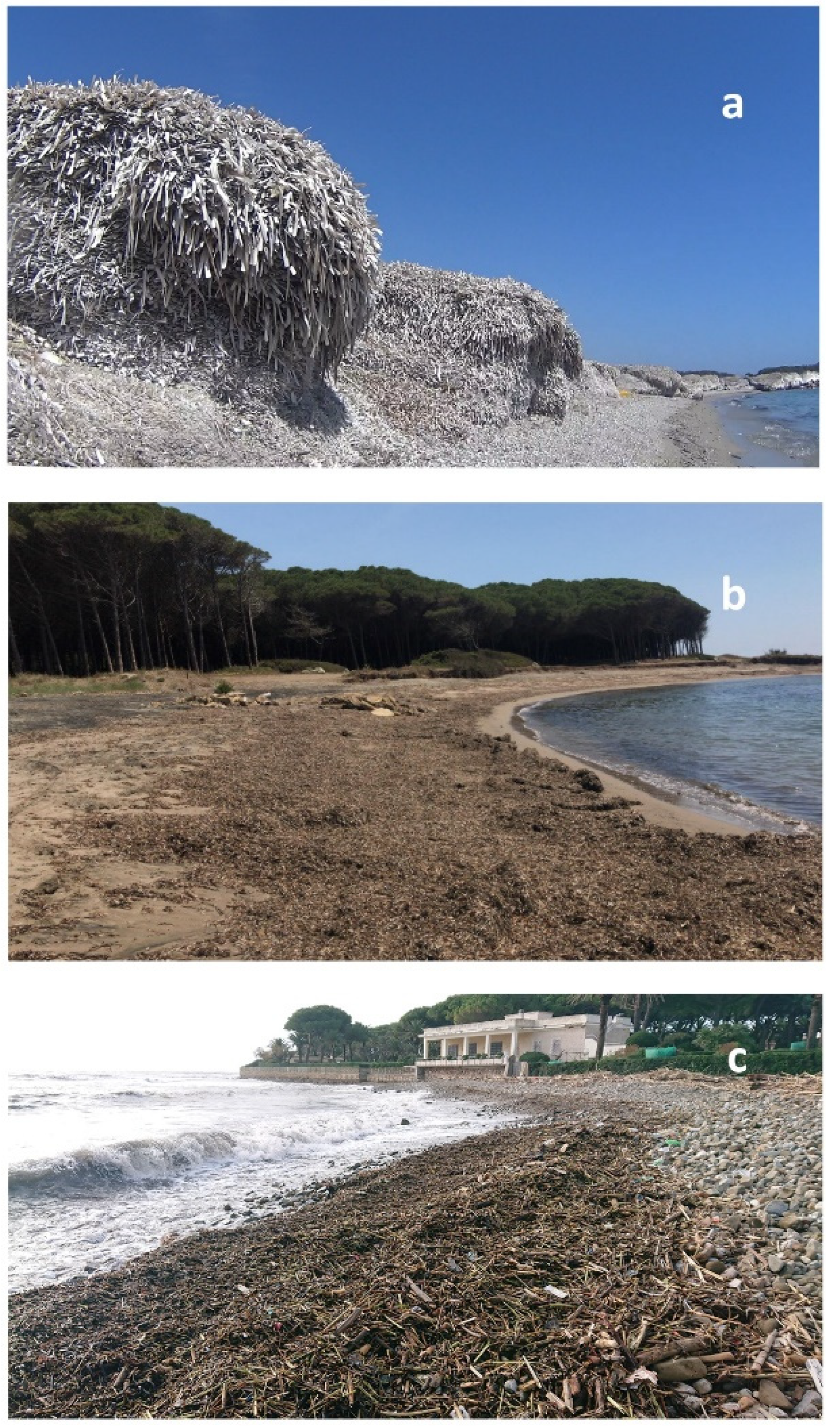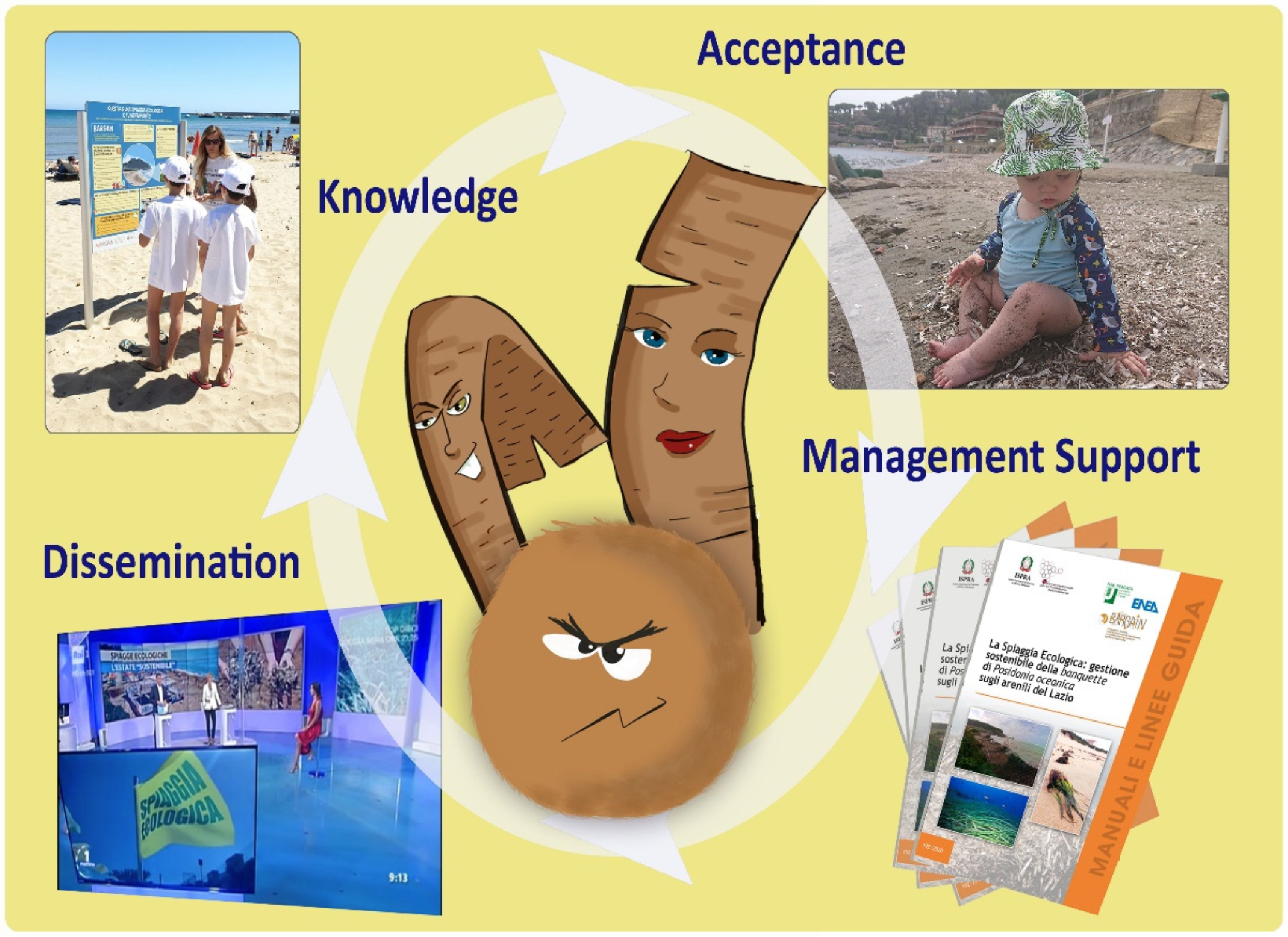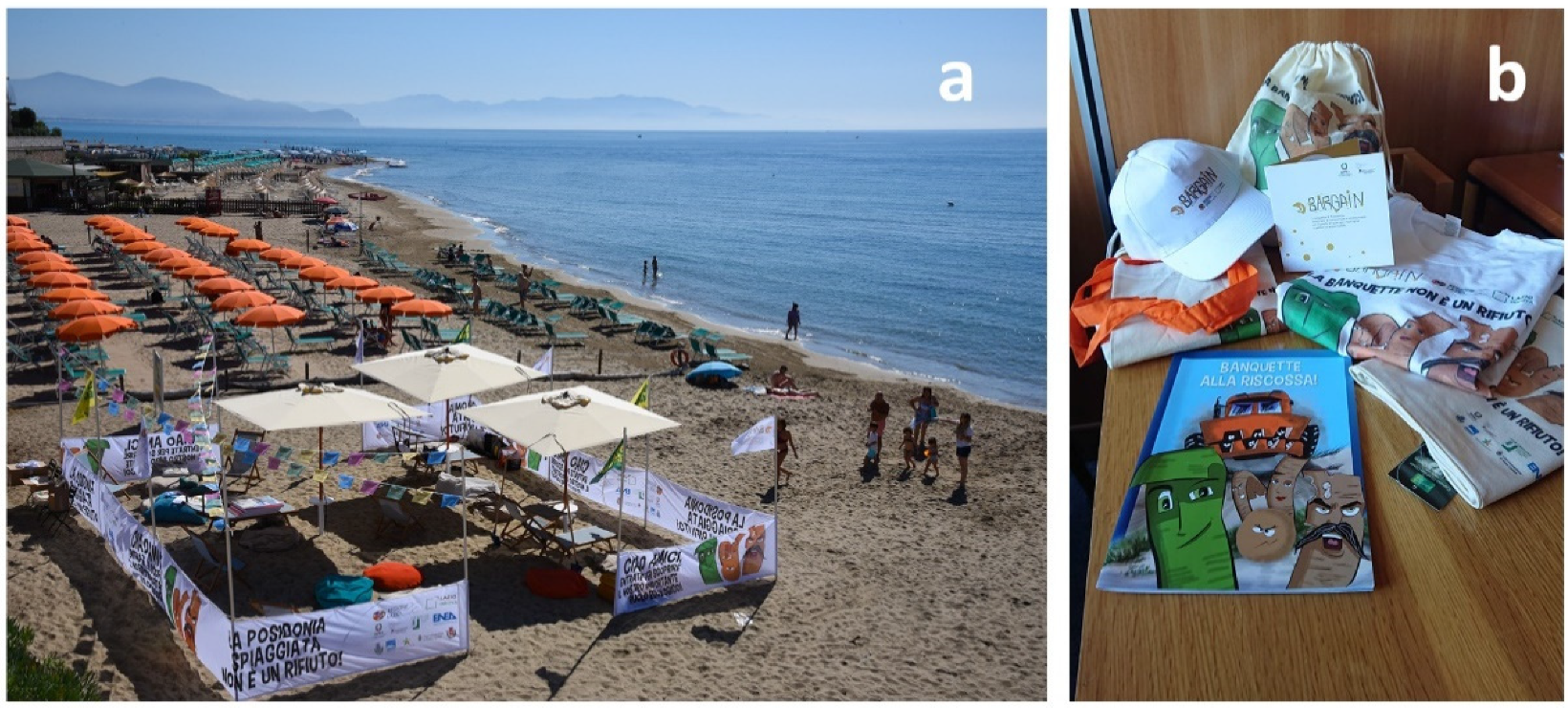Effectiveness of the “Ecological Beach” Model: Beneficial Management of Posidonia Beach Casts and Banquette
Abstract
1. Introduction
2. Preliminary Assessment
2.1. Legislation Framework
2.2. Geographical and Ecological Framework
2.2.1. Identification of the Sites of Seagrass Heaps
2.2.2. Characterization of Seagrass Beach Cast
- Well-structured deposits, mainly composed of intact leaves and rhizomes, often characterized by leaf/sand stratification, with distinctive inclined lying and landward immersion; the stratification may reach up to meters, as in the areas not exposed to the strength of waves;
- Unstructured deposits, mainly composed of senescent/decayed leaves and rhizome residues (advanced maturation stage);
- Unstructured mixed deposits, composed of a minor fraction of senescent leaves and rhizome residues (highly fragmented) and a major presence of other plant material, including waste.
3. Integrated Strategy for the Ecological Beach Model
3.1. Management Options
3.1.1. On-Site Preservation
3.1.2. Displacement
3.2. Waste Removal and Impact Reduction
3.3. Building the Knowledge of Local Stakeholders
Environmental Education Programs
4. Discussion
- (a)
- The publication of the technical guidelines for the Ecological Beach model (https://www.isprambiente.gov.it/en/publications/handbooks-and-guidelines/the-ecological-beach-sustainable-management-of-the-posidonia-banquette-along-the-lazio-shorelines?set_language=en);
- (b)
- The realization of the first two ecological beaches in the Lazio Region (June 2020) with informative panels, demonstration spaces for on-site preservation, the possible reuse of posidonia residues and the distribution of dedicated gadgets (Figure 4);
- (c)
- Distance-learning activities with the schools involved in the project, through webinars and short video-lessons, now available online free of charge (https://www.youtube.com/playlist?list=PLgiaZpXFwy3utkWifKTC6-S5A9CWL1n1W);
- (d)
- The creation of a comic (see Supplementary Material, File S2) and a cartoon both in Italian and English;
- (e)
- The high diffusion of the key information of the project through mass media (radio and TV interviews) and participation in scientific divulgation events and scientific festivals of national and international relevance.
5. Conclusions
Supplementary Materials
Author Contributions
Funding
Acknowledgments
Conflicts of Interest
References
- Boudouresque, C.F.; Pergent, G.; Pergent-Martini, C.; Ruitton, S.; Thibaut, T.; Verlaque, M. The necromass of the Posidonia oceanica seagrass meadow: Fate, role, ecosystem services and vulnerability. Hydrobiologia 2016, 781, 25–42. [Google Scholar] [CrossRef]
- Del Vecchio, S.; Jucket, T.; Carboni, M.; Acosta, A.T.R. Linking plant communities on land and at sea: The effects of Posidonia oceanica wrack on the structure of dune vegetation. Estuar. Coast. Mar. Sci. 2017, 184, 30–36. [Google Scholar] [CrossRef]
- Cantasano, N. Management plan for the beach-cast seagrass in Calabria. In National Research Council of Italy; Marine Research at CNR, Chapter: DTA/06-2011; Department of Earth and Environment, National Research Council of Italy: Roma, Italy, 2011; pp. 1173–1182. [Google Scholar]
- ISPRA. Formazione e gestione delle banquettes di Posidonia oceanica sugli arenili. In Manuali e Linee Guida; ISPRA: Roma, Italy, 2010; Volume 55, p. 124. [Google Scholar]
- ISPRA. La Spiaggia Ecologica: Gestione sostenibile della banquette di Posidonia oceanica sugli arenili del Lazio. In Manuali e Linee Guida; ISPRA: Roma, Italy, 2020; Volume 192, p. 51. [Google Scholar]
- Cappucci, S.; Creo, C.; Cristallo, V.; De Simone, C.; Donati, S.; Russo, M.; Simoncelli, I. Multifunctional structure made with seagrass wrack: A patent of the GE.RI.N project. Energy Ambiente ed Innov. 2015, 4, 83–90. [Google Scholar] [CrossRef]
- Mossone, P.; Guala, I.; Heurtefeux, H.; Giunta Fornasin, M.E.; Issaris, Y.; Gerakaris, V.; Salomidi, M.; Milano, P.; Guido, M.; Marciano, V.; et al. POSBEMED: Posidonia Beach/Dunes Socio-Economic Evaluation. Final Report; Technical Report; IMC Foundation—International Marine Centre: Torre Grande, Italy, 2018; Volume 2, p. 70. [Google Scholar] [CrossRef]
- Otero, M.M.; Simeone, S.; Aljinovic, B.; Salomidi, M.; Mossone, P.; Giunta Fornasin, M.E.; Gerakaris, V.; Guala, I.; Milano, P.; Heurtefeux, H.; et al. Governance and management of Posidonia beach-dune system. In POSBEMED Interreg Med Project; IUCN Centre for Mediterranean Cooperation: Málaga, Spain, 2018; p. 66. [Google Scholar]
- Daby, D. Effects of seagrass bed removal for tourism purposes in a Mauritian bay. Environ. Pollut. 2003, 125, 313–324. [Google Scholar] [CrossRef]
- Mossbauer, M.; Haller, I.; Dahlke, S.; Schernewski, G. Management of stranded eel-grass and macroalgae along the German Baltic coastline. Ocean Coast. Manag. 2012, 57, 1–9. [Google Scholar] [CrossRef]
- Risén, E.; Nordström, J.; Malmström, M.E.; Gröndahl, F. Non-market values of algae beach-cast management—Study site Trelleborg, Sweden. Ocean Coast. Manag. 2017, 140, 59–67. [Google Scholar] [CrossRef]
- Ruiz-Frau, A.; Krause, T.; Marbà, N. In the blind-spot of governance—Stakeholder perceptions on seagrasses to guide the management of an important ecosystem services provider. Sci. Total. Environ. 2019, 688, 1081–1091. [Google Scholar] [CrossRef]
- Roig-Munar, F.X.; Rodríguez-Perea, A.; Martín-Prieto, J.Á.; Gelabert Ferrer, B. Quantification of sediment loss due to the mechanical removal of berms (banquettes) of Posidonia oceanica on the beaches of the Balearic Islands: Geomorphological consequences. Rev. Soc. Geol. España 2019, 32, 73–86. [Google Scholar]
- De Falco, G.; Simeone, S.; Baroli, M. Management of beach-cast Posidonia oceanica seagrass on the Island of Sardinia (Italy, Western Mediterranean). J. Coast. Res. 2008, 24, 69–75. [Google Scholar] [CrossRef]
- Botero, C.M.; Cervantes, O.D.; Finkl, C.W. (Eds.) Beach Management Tools—Concepts, Methodologies and Case Studies, 1st ed.; Coastal Research Library 24 Springer Nature: Berlin/Heidelberg, Germany, 2018; 960p. [Google Scholar]
- IPBES. Regional Assessment Report on Biodiversity and Ecosystem Services for Europe and Central Asia; IPBES/6/INF/6/rev.1; IPBES: Bonn, Germany, 2018. [Google Scholar] [CrossRef]
- Boudouresque, C.F. Ne touchez pas aux feuilles de posidonies sur les plages! Posidonies: L’écosystème-miracle. Le Tropézien 2010, 70, 12–13. [Google Scholar]
- Nordlund, L.M.; Jackson, E.L.; Nakaoka, M.; Samper-Villarreal, J.; Beca-Carretero, P.; Creed, J.C. Seagrass ecosystem services–What’s next? Mar. Pollut. Bull. 2018, 134, 145–151. [Google Scholar] [CrossRef] [PubMed]
- Gasquy, M.; Gérardin, C.; Van Eynde, C. Les Laisses de Mer; Parc national de Port-Cros publ: Hyères, France, 2014; pp. 1–6. [Google Scholar]
- Serantoni, É. La gestion des dépôts marins sur les plages de l’île de Porquerolles, située en zone coeur du Parc national de Port-Cros (Provence, France). Sci. Rep. Port Cros. Natl. Park 2015, 29, 223–235. [Google Scholar]
- Boudouresque, C.F.; Ponel, P.; Astruch, P.; Barcelo, A.; Blanfuné, A.; Geoffroy, D.; Thibaut, T. The high heritage value of the Mediterranean sandy beaches, with a particular focus on the Posidonia oceanica “banquettes”: A review. Sci. Rep. Port Cros. Natl. Park 2017, 31, 23–70. [Google Scholar]
- Council Directive 92/43/EEC of 21 May 1992 on the Conservation of Natural Habitats and of Wild Fauna and Flora. Off. J. Eur. Union 1992, L206, 7–50. Available online: https://eur-lex.europa.eu/legal-content/EN/TXT/?uri=celex%3A31992L0043. (accessed on 10 September 2020).
- Directive 2000/60/EC of the European Parliament and of the Council of 23 October 2000 Establishing a Framework for Community Action in the Field of Water Policy. Off. J. Eur. Union 2000, L327, 1–73. Available online: https://eur-lex.europa.eu/legal-content/EN/TXT/?uri=celex%3A32000L0060 (accessed on 10 September 2020).
- Legislative Decree of 152/2006 “Norme in Materia Ambientale” Pubblicato Nella Gazzetta Ufficiale n. 88 del 14 Aprile 2006—Supplemento Ordinario n. 96; MATTM: Rome, Italy, 2006. Available online: https://www.gazzettaufficiale.it/dettaglio/codici/materiaAmbientale (accessed on 10 September 2020).
- Ministry Decree of November, 8, 2010, n. 260 Regolamento recante i criteri tecnici per la classificazione dello stato dei corpi idrici superficiali, per la modifica delle norme tecniche del decreto legislativo 3 aprile 2006, n. 152, recante norme in materia ambientale, predisposto ai sensi dell’articolo 75, comma 3, del medesimo decreto legislativo. In G.U n. 30 del 7 febbraio 2011. Available online: https://www.gazzettaufficiale.it/eli/id/2011/02/07/011G0035/sg (accessed on 10 September 2020).
- Directive 2008/56/EC of the European Parliament and of the Council of 17 June 2008 Establishing a Framework for Community Action in the Field of Marine Environmental Policy (Marine Strategy Framework Directive). Off. J. Eur. Union 2008, L164, 19–40. Available online: https://eur-lex.europa.eu/legal-content/EN/TXT/?uri=celex%3A32008L0056 (accessed on 10 September 2020).
- Legislative Decree of October, 13th, 2010, n. 190 Attuazione della direttiva 2008/56/CE che istituisce un Quadro per l’azione Comunitaria nel Campo Della Politica Per L’ambiente marino. In GU del 18 novembre 2010. Available online: https://www.gazzettaufficiale.it/atto/serie_generale/caricaDettaglioAtto/originario?atto.dataPubblicazioneGazzetta=2010-11-18&atto.codiceRedazionale=010G0212&elenco30giorni=false (accessed on 10 September 2020).
- Dumping Protocol. Protocol for the Prevention and Elimination of Pollution of the Mediterranean Sea by Dumping from Ships and Aircraft or Incineration at the Sea Adopted in 1976 Amended in 1995. Available online: https://wedocs.unep.org/bitstream/id/53220/consolidated_dumping_eng.pdf (accessed on 10 September 2020).
- Barcelona Convention 1995. Convention for the Protection of the Mediterranean Sea Against Pollution adopted on 16 February 1976 Amended in 1995. Available online: https://ec.europa.eu/environment/marine/international-cooperation/regional-sea-conventions/barcelona-convention/index_en.htm (accessed on 31 August 2020).
- MAP, 1975. The Mediterranean Action Plan as the Institutional Framework for Cooperation in Addressing Common Challenges of Marine Environmental Degradation. Available online: https://wedocs.unep.org/bitstream/handle/20.500.11822/5251/75wg2_5_mapphasei_eng.pdf (accessed on 31 August 2020).
- Law/Legge 27 maggio 1999, n. 175 Ratifica ed esecuzione dell’Atto finale della Conferenza dei plenipotenziari sulla Convenzione per la Protezione del Mar Mediterraneo dall’inquinamento, con relativi protocolli, tenutasi a Barcellona il 9 e 10 giugno 1995. In GU 140 del 17 Giugno 1999. Available online: https://www.gazzettaufficiale.it/eli/id/1999/06/17/099G0254/sg (accessed on 31 August 2020).
- Circular of Ministry of the Environment and Protection of the Territory and the Sea, n. 8838/2019 “gestione degli accumuli di Posidonia oceanica spiaggiati”. Available online: https://www.minambiente.it/sites/default/files/archivio/allegati/rifiuti/circolare_rin_posidonia_8838_20052019.pdf (accessed on 31 August 2020).
- Circular of Ministry of the Environment and Protection of the Territory and the Sea, n. 8123/2006 “gestione degli accumuli di Posidonia oceanica spiaggiati”. Available online: https://www.isprambiente.gov.it/files/temi/Circolare_MATTM_2006.pdf (accessed on 31 August 2020).
- Legislative Decree of 29 April 2010, n. 75 Riordino e revisione della disciplina in materia di fertilizzanti, a norma dell’articolo 13 della legge 7 luglio 2009, n. 88 In GU N. 121 DEL 26 MAGGIO 2010. Available online: https://www.gazzettaufficiale.it/eli/id/2010/05/26/010G0096/sg (accessed on 10 September 2020).
- Ministry Decree/ Decreto Ministeriale del Ministero delle Politiche Agricole e Forestali del 22 gennaio 2009 Aggiornamento degli allegati al decreto legislativo 29 aprile 2006, n. 217, concernente la revisione della disciplina in materia di fertilizzanti in GU n.88 del 16-04-2009. Available online: https://www.gazzettaufficiale.it/atto/serie_generale/caricaDettaglioAtto/originario?atto.dataPubblicazioneGazzetta=2009-04-16&atto.codiceRedazionale=09A03940&elenco30giorni=false (accessed on 10 September 2020).
- Royal Decree 139/2011 of 4 February for the development of the Wildlife Species List under the Special Protection Regime and the Spanish Catalogue of Threatened Species. Available online: https://www.boe.es/buscar/pdf/2011/BOE-A-2011-3582-consolidado.pdf (accessed on 10 September 2020).
- Ley 42/2007, de 13 de diciembre, del Patrimonio Natural y de la Biodiversidad. Available online: https://www.boe.es/buscar/act.php?id=BOE-A-2007-21490 (accessed on 10 September 2020).
- POSIDUNE. Technical Report—Phase A (BeachMed-e 2007a). In Interactions de Posidonia Oceanica et Sable avec l’Environnement des Dunes Naturelles; EMODnet: New York, NY, USA, 2007; 181p, Available online: http://www.coastalmapping.eu/index.php?option=com_phocadownload&view=category&id=8&Itemid=149. (accessed on 10 September 2020).
- Cappucci, S.; Valentini, E.; Del Monte, M.; Paci, M.; Filipponi, F.; Taramelli, A. Detection of natural and anthropic features on small islands. J. Coast. Res. 2017, 77, 74–88. [Google Scholar] [CrossRef]
- Corbí, H.; Riquelme, A.; Megías-Baños, C.; Abellan, A. 3-D Morphological Change Analysis of a Beach with Seagrass Berm Using a Terrestrial Laser Scanner. ISPRS Int. J. Geo Inf. 2018, 7, 234. [Google Scholar] [CrossRef]
- Turner, I.L.; Harley, M.D.; Drummond, C.D. UAVs for coastal surveying. Coast. Eng. 2016, 114, 19–24. [Google Scholar] [CrossRef]
- Ventura, D.; Bonifazi, A.; Gravina, M.F.; Belluscio, A.; Ardizzone, G. Mapping and Classification of Ecologically Sensitive Marine Habitats Using Unmanned Aerial Vehicle (UAV) Imagery and Object-Based Image Analysis (OBIA). Remote Sens. 2018, 10, 1331. [Google Scholar] [CrossRef]
- Gómez-Pujol, L.; Orfila, A.; Álvarez-Ellacuría, A.; Terrados, J.; Tintoré, J. Posidonia oceanica beach-caster litter in Mediterranean beaches: A coastal videomonitoring study. J. Coast. Res. 2013, 165, 1768–1773. [Google Scholar] [CrossRef]
- Simeone, S.; De Falco, G. Posidonia oceanica banquettes removal: Sedimentological, geomorphological and ecological implications. J. Coast. Res. 2013, 65, 1045–1050. [Google Scholar]
- Valentini, N.; Balouin, Y. Assessment of a Smartphone-Based Camera System for Coastal Image Segmentation and Sargassum monitoring. J. Mar. Sci. Eng. 2020, 8, 23. [Google Scholar] [CrossRef]
- Harley, M.D.; Kinsela, M.A.; Sánchez-García, E.; Vos, K. Shoreline change mapping using crowd-sourced smartphone images. J. Coast. Eng. 2019, 150, 175–189. [Google Scholar] [CrossRef]
- Pietrelli, L.; Di Gennaro, A.; Menegoni, P.; Lecce, F.; Poeta, G.; Acosta, A.T.; Battisti, C.; Iannilli, V. Pervasive plastisphere: First record of plastics in egagropiles (Posidonia spheroids). Env. Pollut. 2017, 229, 1032–1036. [Google Scholar] [CrossRef] [PubMed]
- Wheeler, A. Designing Brand Identity: An Essential Guide for the Whole Branding Team; John Wiley & Sons Inc.: Hoboken, NJ, USA, 2017. [Google Scholar]
- Borrello, P.; Silvestri, C.; Nicoletti, L. Posidonia Spiaggiata, una Risorsa Ambientale in Programma di Iniziative di Educazione Ambientale per la Sostenibilità 2019 (anno Scolastico 2019/2020). Available online: https://www.isprambiente.gov.it/it/attivita/formeducambiente/educazione-ambientale/progetti-ed-iniziative-1/educazione-ambientale-per-le-scuole-il-programma-di-iniziative-dell2019ispra (accessed on 10 September 2020).
- APAT. I Processi Educativi in Linee Guida per l’educazione Ambientale nel Sistema Agenziale 2006; APAT: Rome, Italy, 2006; pp. 39–44. ISBN 88-448-0130-2. [Google Scholar]
- Borrello, P.; Silvestri, C.; Nicoletti, L. Appunti di Viaggio: Posidonia Spiaggiata, una Risorsa Ambientale 2018 (Anno Scolastico 2017/2018). Available online: https://www.isprambiente.gov.it/it/attivita/formeducambiente/educazione-ambientale/progetti-ed-iniziative-1/posidonia-spiaggiata-una-risorsa-ambientale (accessed on 10 September 2020).
- Biato, P. Tarocchi Fiabeschi e Psicofiaba; Verdechiaro edizioni, Baiso (RE): Rome, Italy, 2016. [Google Scholar]
- Roig-Munar, F.X.; Martín-Prieto, J.Á.; Rodríguez-Perea, A.; Balaguer, P. Gestión litoral en Menorca: Un modelo basado en criterios geomorfológicos. En: Geomorfología litoral de Menorca: Dinámica, evolución y prácticas de gestión, (Ll. Gómez-Pujol, G.X. Pons, Eds). Monografía Societat Historia Natural Balears 2017, 25, 191–212. [Google Scholar]
- Roig-Munar, F.X.; Martín Prieto, J.Á.; Pintó, J.; Rodríguez-Perea, A.; Gelabert, B. Coastal management in the Balearic Islands. En: The Spanish coastal systems. In Dynamic Processes, Sediments and Management; Morales, J.A., Ed.; Springer: Berlin/Heidelberg, Germany, 2019; pp. 765–787. [Google Scholar]
- Mateo, M.A.; Sanchez-Lizaso, J.L.; Romero, J. Posidonia oceanica ‘banquettes’: A preliminary assessment of the relevance for meadow carbon and nutrients budget. Estuar. Coast. Shelf Sci. 2003, 56, 85–90. [Google Scholar] [CrossRef]
- Simeone, S.; De Falco, G. Morphology and composition of beach-cast Posidonia oceanica litter on beaches with different exposures. Geomorphology 2012, 151–152, 224–233. [Google Scholar] [CrossRef]
- Vacchi, M.; Marriner, N.; Morhange, C.; Spada, G.; Fontana, A.; Rovere, A. Multiproxy assessment of Holocene relative sea-level changes in the western Mediterranean: Sea-level variability and improvements in the definition of the isostatic signal. Earth Sci. Rev. 2016, 155, 172–197. [Google Scholar] [CrossRef]
- Pallottini, E.; Cappucci, S. Beach-dune system interaction and evolution. Rendiconti online. Soc. Geol. It. 2009, 8, 87–97. [Google Scholar]
- Valentini, E.; Taramelli, A.; Cappucci, S.; Filipponi, F.; Nguyen Xuan, A. Exploring the dunes: The correlations between vegetation cover pattern and morphology for sediment retention assessment using airborne multisensor acquisition. Remote Sens. 2020, 12, 1229. [Google Scholar] [CrossRef]
- Pascucci, V.; Cappucci, S.; Andreucci, S.; Donda, F. Sedimentary features of the offshore part of the la Pelosa Beach (Sardinia, Italy). Rendiconti on line Soc. Geol. It. 2008, 2, 1–3. [Google Scholar]
- Azzurro, E.; Sbragaglia, V.; Cerri, J.; Bariche, M.; Bolognini, L.; Ben Souissi, J.; Busoni, G.; Coco, S.; Chryssanthi, A.; Fanelli, E.; et al. Climate change, biological invasions, and the shifting distribution of Mediterranean fishes: A large-scale survey based on local ecological knowledge Glob. Chang. Biol. 2019, 25, 2779–2792. [Google Scholar] [CrossRef] [PubMed]
- Parente, A.; Santamaria, P. Il Caso dei Residui Spiaggiati di Posidonia Oceanica: Da Rifiuto a Risorsa; Levante Editori: Bari, Italy, 2009; 201p. [Google Scholar]
- Fu, H.; Liu, X. A Study on the Impact of Environmental Education on Individuals’ Behaviors Concerning Recycled Water Reuse. EURASIA J. Math. Sci. Technol. Educ. 2017, 13, 6715–6724. [Google Scholar] [CrossRef]
- Ardoin, N.M.; Bowers, A.W.; Roth, N.W.; Holthuis, N. Environmental education and K-12 student outcomes: A review and analysis of research. J. Environ. Educ. 2018, 49, 1–17. [Google Scholar] [CrossRef]
- Liefländer, A.K.; Fröhlich, G.; Bogner, F.X.; Schultz, W.P. Promoting Connectedness with Nature through Environmental Education. J. Environ. Educ. Res. 2013. [Google Scholar] [CrossRef]




Publisher’s Note: MDPI stays neutral with regard to jurisdictional claims in published maps and institutional affiliations. |
© 2020 by the authors. Licensee MDPI, Basel, Switzerland. This article is an open access article distributed under the terms and conditions of the Creative Commons Attribution (CC BY) license (http://creativecommons.org/licenses/by/4.0/).
Share and Cite
Rotini, A.; Chiesa, S.; Manfra, L.; Borrello, P.; Piermarini, R.; Silvestri, C.; Cappucci, S.; Parlagreco, L.; Devoti, S.; Pisapia, M.; et al. Effectiveness of the “Ecological Beach” Model: Beneficial Management of Posidonia Beach Casts and Banquette. Water 2020, 12, 3238. https://doi.org/10.3390/w12113238
Rotini A, Chiesa S, Manfra L, Borrello P, Piermarini R, Silvestri C, Cappucci S, Parlagreco L, Devoti S, Pisapia M, et al. Effectiveness of the “Ecological Beach” Model: Beneficial Management of Posidonia Beach Casts and Banquette. Water. 2020; 12(11):3238. https://doi.org/10.3390/w12113238
Chicago/Turabian StyleRotini, Alice, Stefania Chiesa, Loredana Manfra, Patrizia Borrello, Raffaella Piermarini, Cecilia Silvestri, Sergio Cappucci, Luca Parlagreco, Saverio Devoti, Marco Pisapia, and et al. 2020. "Effectiveness of the “Ecological Beach” Model: Beneficial Management of Posidonia Beach Casts and Banquette" Water 12, no. 11: 3238. https://doi.org/10.3390/w12113238
APA StyleRotini, A., Chiesa, S., Manfra, L., Borrello, P., Piermarini, R., Silvestri, C., Cappucci, S., Parlagreco, L., Devoti, S., Pisapia, M., Creo, C., Mezzetti, T., Scarpato, A., & Migliore, L. (2020). Effectiveness of the “Ecological Beach” Model: Beneficial Management of Posidonia Beach Casts and Banquette. Water, 12(11), 3238. https://doi.org/10.3390/w12113238










